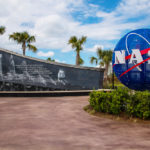NASA sends a crew capsule to the Moon. Is Mars the next?

Ingus Kruklitis / Shutterstock.com
NASA’s new mega moon rocket, the Space Launch System (SLS), soared into space early Wednesday morning, lighting up the night sky above the Kennedy Space Center in Florida.
The mission, which is many years and multiple billions over budget, aims to send an Orion crew capsule on a journey around the moon.
“We are all part of something incredibly special,” Charlie Blackwell-Thompson, the launch director, told her team after the successful liftoff. “The first launch of Artemis and the first step in returning our country to the moon and [eventually] on to Mars.”
For NASA, the launch begins a new era of lunar exploration that intends to culminate in astronauts returning to the lunar surface for the first time in 50 years.
Researchers hope to discover the moon’s hidden secrets, like what kind of materials lurk in the shadowy regions of the lunar poles, what kind of resources are available for future crewed missions and what resources could be leveraged to aid in reaching Mars.
But before NASA could unlock those secrets, this first mission had to get off the ground. After multiple scrubs and rollbacks and even hurricanes, the four engines on the rocket’s core stage ignited at 1:47 a.m. ET on Wednesday, along with its two solid rocket boosters, propelling the behemoth skyward.
What comes next?
Announcements will be made soon on who will be the first astronauts to strap into the Orion crew capsule. On its next mission, the SLS rocket will carry four astronauts on a flight around the moon. This will be a precursor to a lunar landing, where four more astronauts will fly to the moon, with two actually stepping onto the lunar surface.
Artemis II is slated to launch in 2024, with Artemis III on its heels in 2025 — if the current schedule holds. The Artemis IV mission, currently slated for 2027, will be the first to inhabit the planned lunar outpost NASA calls Gateway.
The Artemis program is an international collaboration, with many nations participating. As part of Canada’s agreement, the country will contribute a robotic arm to use on Gateway. Designed much like the robotic arms that served the space shuttle and now the International Space Station, the tool will earn a Canadian astronaut a spot on the Artemis II crew.
An astronaut from the European Space Agency will be part of the Artemis IV crew, and will help deliver a European-built habitation module to Gateway outpost.
Many of the details concerning crew members have not yet been disclosed; however, NASA is expected to make announcements for its upcoming Artemis II mission early in the new year.
When Trump was in office, his administration announced that it wanted to accelerate NASA’s lunar ambitions. To that end, it was decided that the Artemis III crew would include “the first woman and the next man” to walk on the moon.
Under the Biden administration, the phrasing has changed to “the first woman and first person of color,” but in reference to more general Artemis missions and not specifically to Artemis III.
NASA has a vast and diverse corps of astronauts today, with its newest class, selected in 2021, scheduled to complete training before any of these missions take off. That gives the agency a large pool of individuals to sort through for these high-profile missions.
The Artemis I mission will last for 25 days, and assuming it completes all of its objectives, the rocket will land safely in the Pacific Ocean next month.
There’s speculation that NASA could announce its first four moon-bound astronauts after the new year.
Whoever is selected, they will eventually pop out of a SpaceX Starship. NASA has tasked the private spaceflight company with building a human landing system variant of its massive Starship rocket. As part of the deal, the company will provide a series of landing demonstrations, including an uncrewed demo before Artemis III.
“Returning astronauts to the Moon to learn, live, and work is a bold endeavor,” NASA Administrator Bill Nelson said in a statement. “With multiple planned landers, from SpaceX and future partners, NASA will be better positioned to accomplish the missions of tomorrow: conducting more science on the surface of the Moon than ever before and preparing for crewed missions to Mars.”
The Starship variant will do more than just land on the lunar surface — it will also be able to dock with Gateway and shuttle as many as four crew members to and from the lunar surface, along with any cargo or scientific equipment they may need.
NASA says the agency is working with partners other than SpaceX in an effort to develop multiple landing systems, as this component is crucial to the success of the program.
The hardware will help prepare the agency for the ultimate giant leap: Mars.









